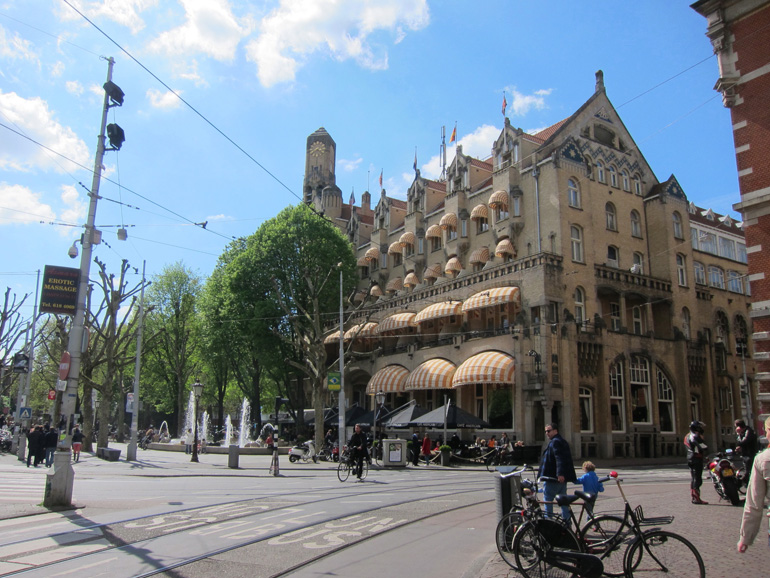Amsterdam/London:
Wandeling
13 May 2012
We are not staying at the Hotel American, but we have a painting of it in our living room at home, so of course I had to try to get a better photograph of it than the one I took ten years ago.
On our first non-travel day in Amsterdam on this, my second trip to Amsterdam, I managed without really intending to do so to recapitulate everything that I liked about the first visit. Kathleen and I walked from our hotel, at the southern edge of De Pijp, to the Dam and back, and we never retraced our steps to any significant degree. (Strictly speaking, I believe, we did not retrace any steps at all aside from the Singel embankment between the Leidestraat and the Spui.) But I had been almost everywhere before, and almost everywhere that we went had a personal resonance. Take the Leidestraaat itself: how many times did I walk up and down that street ten years ago? Probably fewer than a dozen, but it felt more like a semester’s worth. With the Athenaeum, the American Book Center, and Waterstone’s, the Spui is something of a book district, and it is also the home of the Café Luxembourg, which I patronised often enough last time to regard it as a personal hang-out. On the way home, I realized that Van Baerlestraat, which Kathleen wanted to pass along in search of a stop that she liked, constituted close to a bee-line between the Leidesplein (where I’d thought about making a rest stop at the American) and our hotel. We had walked much of the street the last time I was here (this is Kathleen’s fifth visit) because I’d cajoled Kathleen into seeing an exhibition of maps of Amsterdam at the Municipal Archives — rather more of a walk than Kathleen, not quite as keen about cartography as I am, had in mind. (Van Baerlestraat is also the address of the Concertgebouw, which I have yet to get inside of; and it forms the southern edge of the big lawn behind the Rijksmuseum and the Van Gogh Museum.) Since my goals for the day were modest — I wanted (a) to buy a copy of the writings of J H F Grönloh, formally known as “Nescio” (pronounced, I now know for sure, “Nessio”), and (b) to have lunch at the Luxembourg — my success left me without any further ideas, and the sheer favorable drift of the rest of the day was an unimagined gift.
There were a couple of new things. We walked into the Begijnhof, about which, for the moment, I am only going to say that it’s a good thing that there wasn’t one in New York City thirty years ago, because I don’t think that Kathleen would have married me if something like it had been an option. (“Hard to say,” was Kathleen’s opinion.) And we walked down the Kalverstraat, which, according to an article in the Times, is “Amsterdam’s busiest shopping street.” Yes, it probably is! But I had been mislead by the reporter’s conversation with a sales clerk specialising in Mont Blanc pens into the sloppy conclusion that “busiest” meant “most luxurious.” That, it definitely is not. It has been a long time since my last visit to an American shopping mall, but that’s what the emporia of the Kalverstraat brought to mind. I ought to have known better, because I walked along the Pieter Cornelisz Hoofstraat a few times in 2002 (it was right round the corner from our hotel at the time), and that’s where the Gucci shop is. Not anywhere near Kalverstraat, which is tat from end to end.
***
At the Athenaeum newsstand, which was open at 11:55, when we reached the Spui and found that the Athenaeum itself doesn’t open until noon on Sunday, I bought a copy of Het Parool, the newspaper that I adopted ten years ago, and read the following headline: “Amsterdam moet nog veel meer extra bezuinigen,” and I understood it well enough (with a little help from my grasp of current affairs) to know that the last word, which I didn’t recognize, must mean something like “to go on a diet.” Which it does, actually; it means “to economize.” (I was able to buy a handy dictionary right after lunch; knowing that I’d buy new ones anyway, I had left my collection at home.) I was amazed, all day, by how intelligible the local language was. Years of desultorily listening to Teach Yourself Dutch have apparently opened a crack in my brain through which something like familiarity has seeped. Asking myself why I study a language all the educated speakers of which make sure to speak English — and I’m not the only one asking — I have to answer, simply, that I find the language gezellig. That’s one of those untranslatable terms that means much more than its accepted equivalents in English, which in this case include “sociable” and “companionable.”
Amsterdam is certainly the most sociable and companionable city that I’ve ever been to. This isn’t to say that it’s friendly — that’s an American misunderstanding of the facts of life. We can all have only so many friends; the trick is to enjoy living among people who aren’t — and to make sure that they enjoy living with us. There is no contradiction, in this wonderful town, between “civil” and “comfortable,” no sense of constraint about the former that puts the latter off the menu.
Everyone has been very nice about my stabs at Dutch. (Most clerks and servers seem to think that I’m Dutch to begin with, for some reason.) I don’t think that I could say anything intrinsically interesting, but that’s not the point. I’m not called on to say interesting things to people whom I don’t know very well; how obnoxious I would be if I thought that I were.Â

